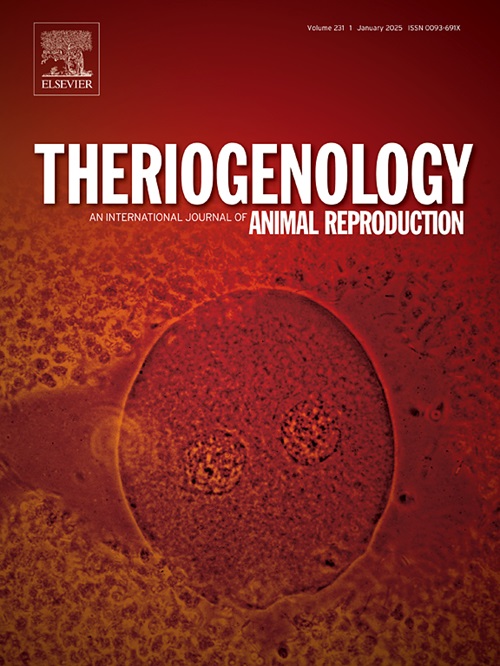KHDC3通过调节YAP信号的差异分布影响早期胚胎的谱系分化
IF 2.4
2区 农林科学
Q3 REPRODUCTIVE BIOLOGY
引用次数: 0
摘要
葡萄胎(HM)的特征是异常的胎儿组织丢失和胎盘绒毛滋养层增生,表明异常的早期胚胎细胞命运分化。临床观察将KH结构域3 (KHDC3)突变与完全葡萄胎(CHM)联系起来,表明KHDC3在早期胚胎发育中可能具有不可预见的作用。早期胚胎的单细胞转录组分析显示,从8细胞期到囊胚期,KHDC3的表达水平存在显著的异质性。初步研究表明,8细胞期KHDC3表达水平的变化可能影响yes相关蛋白(YAP)信号通路。在2细胞阶段敲低单个卵裂球中的KHDC3导致囊胚形成率降低。khdc3敲低(Khdc3-KD)胚胎表现出胚胎细胞谱系分化的中断,其特征是内细胞质量(ICM)标记有机阳离子/肉碱转运蛋白4 (OCT4)的表达减少,营养外胚层(TE)标记尾型同源盒2 (CDX2)的差异表达减少。磷酸化的YAP进入外细胞的细胞核是诱导谱系分化的关键。有趣的是,在Khdc3-KD豆瓣中,外细胞磷酸化YAP的核进入量显著减少。此外,在桑葚胚期,KHDC3的敲低同时破坏了皮质肌动蛋白帽的形成。在这一过程中,顶端皮层产生的力将细胞分离到胚胎内部和外部位置,从而影响ICM和TE的命运规范。我们的研究强调了KHDC3在调节YAP信号通路中的作用,从而在桑葚胚期建立不同的内部和外部细胞分布,从而影响早期胚胎谱系分化。然而,KHDC3通过肌动蛋白细胞骨架影响YAP信号通路的确切机制仍有待完全阐明。鉴于与KHDC3突变相关的复发性流产的严重程度,阐明KHDC3在早期胚胎发育中的独特作用值得进一步研究。本文章由计算机程序翻译,如有差异,请以英文原文为准。
KHDC3 affects the lineage differentiation of early embryo by regulating the differential distribution of YAP signal
Hydatidiform mole (HM) is characterized by abnormal fetal tissue loss and placental villous trophoblastic hyperplasia, indicating aberrant early embryonic cell fate differentiation. Clinical observations linking KH Domain Containing 3 (KHDC3) mutations to complete hydatidiform mole (CHM) suggest a potentially unforeseen role for KHDC3 in early embryonic development. Single-cell transcriptome analysis of early embryos revealed notable heterogeneity in KHDC3 expression levels from the 8-cell to blastocyst stage. Initial investigations indicated that varying KHDC3 expression levels at the 8-cell stage could influence the Yes-associated protein (YAP) signaling pathway. Knocking down KHDC3 in individual blastomeres at the 2-cell stage resulted in reduced blastocyst formation rates. Khdc3-knockdown (Khdc3-KD) embryos exhibited disruptions in embryonic cell lineage differentiation, characterized by decreased expression of the inner cell mass (ICM) marker organic cation/carnitine transporter 4 (OCT4) and diminished differential expression of the trophectoderm (TE) marker caudal type homeobox 2 (CDX2). The nuclear entry of phosphorylated YAP in outer cells is pivotal for inducing lineage differentiation. Intriguingly, in Khdc3-KD morulae, a significant reduction in the nuclear entry of phosphorylated YAP in outer cells was observed. Moreover, KHDC3 knockdown simultaneously impaired cortical actin cap formation during the morula stage. Forces generated at the apical cortex during this process segregate cells into inner and outer positions within the embryo, thereby influencing ICM versus TE fate specification. Our research underscores the role of KHDC3 in modulating the YAP signaling pathway to establish distinct inner and outer cell distributions during the morula stage, consequently influencing early embryonic lineage differentiation. Nevertheless, the precise mechanism by which KHDC3 influences the YAP signaling pathway via the actin cytoskeleton remains to be fully elucidated. Given the severity of recurrent miscarriages associated with KHDC3 mutations, elucidating the distinctive role of KHDC3 in early embryonic development warrants further investigation.
求助全文
通过发布文献求助,成功后即可免费获取论文全文。
去求助
来源期刊

Theriogenology
农林科学-生殖生物学
CiteScore
5.50
自引率
14.30%
发文量
387
审稿时长
72 days
期刊介绍:
Theriogenology provides an international forum for researchers, clinicians, and industry professionals in animal reproductive biology. This acclaimed journal publishes articles on a wide range of topics in reproductive and developmental biology, of domestic mammal, avian, and aquatic species as well as wild species which are the object of veterinary care in research or conservation programs.
 求助内容:
求助内容: 应助结果提醒方式:
应助结果提醒方式:


